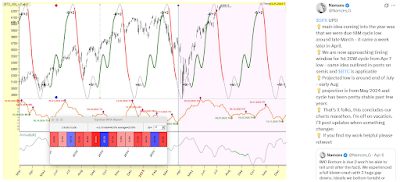Since 1950, whenever the S&P 500 gained 10% or more in the first three quarters and September was positive, the fourth quarter has historically been positive 80% of the time (16 out of 20 years). The average gain for the fourth quarter during these years is 4.42%. The best performance observed was +11.36%, while the worst was a loss of -1.26%.
Looking at 2025, as of September 27, with only two trading days left in the month, the first three quarters of the year have seen a total gain of 12.96%, with 2.84% of that gain coming from September alone.
Looking at 2025, as of September 27, with only two trading days left in the month, the first three quarters of the year have seen a total gain of 12.96%, with 2.84% of that gain coming from September alone.
October: The market has been negative in October 55% of the time (9 years up, 11 down) with an average loss of -0.44%. The best performance was +4.46%, while the worst was -6.86%.
October 20–27: During this specific period, the market has been down 80% of the time (4 years up, 16 down), with an average decline of -1.29%. The best performance was +1.22%, and the worst was -8.23%.
November: In contrast, November has been positive 80% of the time (16 years up, 4 down), with an average gain of +3.41%. The best was a gain of +10.24%, while the worst was a decline of -1.89%.
December: December has been positive 75% of the time (15 years up, 5 down), with an average gain of +1.47%. The best performance was +5.25%, and the worst was -3.39%.
Combining November and December, the performance has been positive 90% of the time (18 years up, 2 down), with an average gain of 4.81%. The best combined performance was +13.57%, while the worst was a modest -0.45%.
The average absolute drawdown in the fourth quarter was -2.66%. The worst was -8.64%, though the period also saw potential upside gains of up to +12.00%.
October 20–27: During this specific period, the market has been down 80% of the time (4 years up, 16 down), with an average decline of -1.29%. The best performance was +1.22%, and the worst was -8.23%.
November: In contrast, November has been positive 80% of the time (16 years up, 4 down), with an average gain of +3.41%. The best was a gain of +10.24%, while the worst was a decline of -1.89%.
December: December has been positive 75% of the time (15 years up, 5 down), with an average gain of +1.47%. The best performance was +5.25%, and the worst was -3.39%.
Combining November and December, the performance has been positive 90% of the time (18 years up, 2 down), with an average gain of 4.81%. The best combined performance was +13.57%, while the worst was a modest -0.45%.
The average absolute drawdown in the fourth quarter was -2.66%. The worst was -8.64%, though the period also saw potential upside gains of up to +12.00%.
Reference:
See also:



.PNG)























